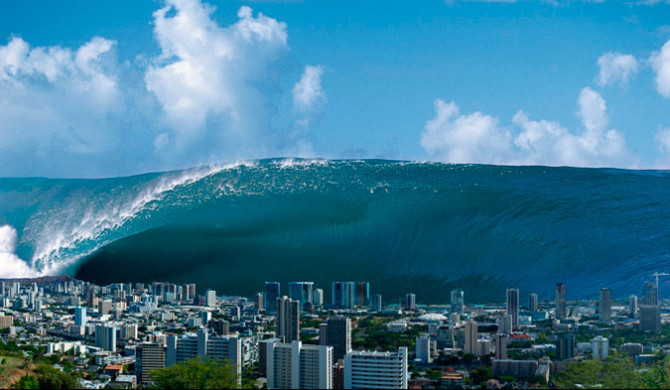
Thankfully, this didn’t happen. Photo: Sean Davey
Even though coastal Californians live in a tsunami-risk zone, the threat doesn’t feel substantial because Californians have never really seen one. In my lifetime, there have been some minor tsunami surges that damaged harbors and marinas, but nothing like what we’ve see on the news such as the 2011 tsunami in Japan, or the 2004 tsunami in the Indian Ocean.
So on December 5, when my phone alerted me of a potential tsunami resulting from a 7.0 earthquake in the waters of Northern California, I figured that this might finally be it. After all, it had been more than three decades since a coastal earthquake in California cracked seven on the Richter scale. In my lifetime, this was unprecedented.
I checked the Surfline cams and refreshed my social media feeds for news of a tsunami. But an hour or so after the alert was made, it was canceled. It begs the question, why did such a strong earthquake not cause a tsunami? The answer lies in the type of earthquake that occurred, not necessarily its strength.
The quake that caused the alert, as it turned out, occurred on a strike-slip fault where two tectonic plates slide by each other side by side. Had the earthquake occurred on a fault in a subduction zone – where one plate slides under the other – this would have had much more potential to uplift the ocean floor and displace large amounts of water.
The epicenter of the quake was 100 miles southwest of Cape Mendocino in an area known as the “triple junction.” It’s where the Pacific, North America, and Juan de Fuca/Gorda plates meet. It marks the terminus of the San Andreas fault and a transition to the subduction zones of the Pacific Northwest.
Thus, there are a lot of different types of tectonic possibilities in this region. It just so happened that this time the quake occurred on a strike-slip fault that allowed the Juan de Fuca/Gorda plates to move eastward relative to the Pacific plate. Crisis averted.
That said, it’s only a matter of time before a tsunami strikes again in California. In 1946 an 8.6 earthquake in Alaska caused a tsunami that flooded parts of the state. An 1812 earthquake near Santa Barbara triggered a tsunami that destroyed coastal villages. Ancient lore tells of a California mega-tsunami in 1700 that left canoes dry in the trees.
And as California’s population climbs to 40 million, the next mega-tsunami will undoubtedly be more destructive than the previous ones.

